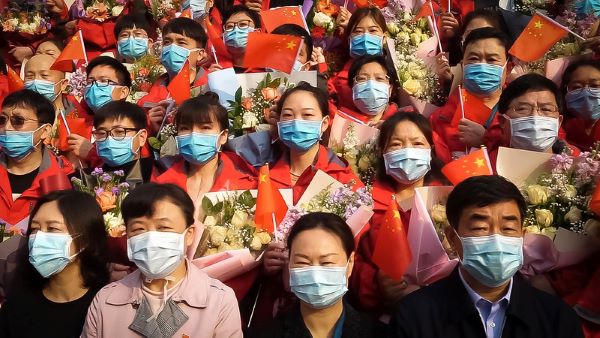
When confronted with early indications of a deadly pandemic, the governments of China and the United States eerily reacted in the same manner, as scrutinized in the probing and debunking documentary In the Same Breath, among the first films kicking off the Sundance Film Festival 2021. Grimly, and in keeping with the film’s theme of multiple informational misfires, its world premiere occurred on the same day that New York’s Attorney General Letitia James announced the deaths of Covid-19 in nursing homes was much higher than Governor Andrew Cuomo’s administration had previously admitted.
Given that a deluge of news related to the Covid-19 virus would make one’s head ache, director Nanfu Wang gingerly jiggles the collective memory of the pandemic’s horrific early days in both countries. Neither nation comes out smelling like roses, or disinfectant for that matter. A brief refresher: on January 7, 2020 (the Year of the Rat), the Chinese government lied about having the disease contained; on January 19, it stated the risk of transmission was low among humans. Its U.S. counterparts handled the burgeoning crisis no better. On January 22, President Trump infamously boasted that the coronavirus was “totally under control.” In mid-February, Dr. Anthony Fauci reassured news viewers: “Don’t worry about it.” On March 10, New York City Mayor Bill De Blasio declared there was “very little threat” from the virus.
But rather than adopting an indignant or scaremongering tone, Wang, who narrates, asks, “How did I not see it coming?” when the United States underwent a rigorous lockdown last spring. Only that January, her husband, co-editor Michael Shade, flew to China to bring back their son from visiting grandparents just as alarming social media reports of a new virus were emerging. So, yeah, Wang had been down this road before.
The absorbing documentary 76 Days, which premiered last fall, focused on the three-month Wuhan lockdown within a number of clinics (one of which, Wuhan Red Cross Hospital, also figures in Wang’s film). Its cameras were primarily embedded with the always busy health care workers and their mostly elderly patients.
Wang takes a wider, more political and contrarian approach. She directed a team of cameramen remotely from the United States, some of whom worked for the film’s investigative cause—another was in it for the money. She and her team uncover what was to become an international pattern: a hospital with no more beds for additional Covid-19 patients turns away an ambulance driver who now has nowhere to take a dying grandmother. (Note to journalists/writers: it’s more than possible to conduct an illuminating and moving interview via a laptop with the interviewer sitting thousands of miles away.)
Although China and the United States faced similar challenges at the start of the pandemic, they diverge when it comes to the control of social media, where in China it’s more restricted, but in the United States, it’s a free-for-all by comparison. Early on, Wang points out that on December 30, 2019, eight Wuhan doctors warned friends and family in a chat room of a new disease. On January 1, they were punished for spreading rumors of an unknown pneumonia.
While covering the pandemic’s U.S. time line, Wang jumps several months from the first cases to the lockdown protests. By that point, the credibility of the Centers for Disease Control had taken a hit. A New Jersey nurse points out that the CDC lied by downplaying the necessity of masks when it should have stated its intention to conserve the then limited supply of protective gear for health care workers.
In angry-American-on-the-street interviews, a man carrying a large American flag claims “they” have inflated Covid-19 numbers. “Accurate information is absolutely imperative,” affirms one MAGA-hat wearing protestor, a comment that becomes more ironic considering her favored candidate’s baseless claims of voter fraud. Though these segments may come across as glib or a compilation of grievances, it leads the filmmaker to pose the questions: What price freedom of speech? How can anyone know the truth when misinformation comes from trusted public figures and institutions?
Given Chinese censorship, it would be a challenge for any filmmaker to capture a wide-ranging overview of how the Chinese have responded to Beijing’s containment policies. It is nevertheless eyebrow-raising to hear so many of Wang’s cherry-picked interviewees expressed alarm over how China’s viewed within the global community. For a month-by-month recounting of the federal government’s missed opportunities and blunders when confronting the Covid-19 crisis, Alex Gibney offers a much more thorough and investigative rehash in Totally Under Control. Presumably, Wang completed her film before a new surge of cases was reported in China and the storming of the U.S. Capitol last month.
Though China’s central government initially contained the pandemic in April, Wang contests the official number of those who died in Wuhan: 3,335. According to an anonymous gravedigger, 20,000 to 30,000 graves were dug during its lockdown, and 10,000 to 20,000 corpses were cremated during this time period, according to another unidentified source connected to a state-run funeral home. Like in Wang’s first film, Hooligan Sparrow, In the Same Breath relies on exciting cloak-and-dagger reporting as she goes undercover, away from government watchdogs.
In the Same Breath will air on HBO later this year.
This review was originally posted on February 10, 2021.






Leave A Comment